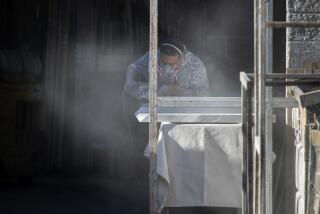Air Inside Factories Rarely Gets Checked
There is no shortage of officials who work to safeguard the health and safety of people outside the factories of Los Angeles County.
Latinos and other workers exposed inside those factories, however, are not nearly so well protected from toxic substances.
The South Coast Air Quality Management District has more than 100 inspectors to monitor industrial air emissions in Los Angeles, Orange, Riverside and San Bernardino counties, but does not check internal air quality of the factories it inspects.
“We don’t have any authority on that,” said Sam Vergara, a supervisor in the AQMD’s air toxics branch. “That’s the health department.”
Wrong, according to Dr. Paul J. Papanek, head of the Los Angeles County Department of Health Services’ Toxics Epidemiology Program. The health department does not monitor air quality in the workplace. That job, Papanek said, belongs to Cal/OSHA, the state’s occupational safety and health program.
Cal/OSHA, however, has fewer than 20 industrial hygienists to test air quality and monitor for toxic overexposure in the region encompassing Los Angeles and Ventura counties. Last year, records show, they conducted 227 inspections--covering about 1% of the more than 20,000 manufacturing workplaces within their jurisdiction.
The local office of the California Division of Labor Standards Enforcement used to regulate health safety standards in the workplace, but rarely does anymore. The division, with three dozen investigators for all of Southern California, mostly looks into violations of hourly wage laws.
“We can check to see if there’s something like an adequate drinking supply when we go in to some place,” said regional manager Roger Miller, “but we usually don’t cite it.”
The Los Angeles County Fire Department, meanwhile, monitors hazardous materials in the factories--yet rarely takes notice of the effects those materials may have on workers, officials said.
The department’s 37-member hazardous materials section checks about 7,000 workplaces to make sure that materials, such as chlorine and cyanide, are properly stored and not a threat to the surrounding community.
“We will make referrals to OSHA or the health department if we see (safety problems),” said Assistant Fire Chief Roger Crow, who until recently headed the section, “but we’re not experts in occupational safety or health . . . and that’s not our responsibility.”
The same is true with the Los Angeles City Fire Department.
“We do not routinely look at things like occupational safety and health,” said Fire Marshal Davis Parsons. “We enforce only those codes we are authorized to enforce.”
More to Read
Sign up for Essential California
The most important California stories and recommendations in your inbox every morning.
You may occasionally receive promotional content from the Los Angeles Times.










